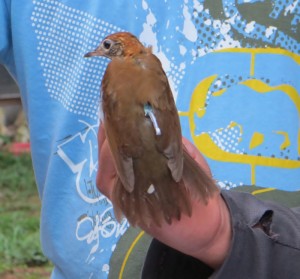Wood Thrush Research Using Geolocators
This year at BFREE we have two researching groups that are here to study a bird called the wood thrush. This bird is a declining threatened species that lives in the US and Canada, but during the winter months, it migrates down to Belize and other Central American countries for warmer weather. Emily McKinnon and Kevin Fraser are the members of one such research group. Emily is completing her final year of banding birds here. For the past 3 years, she has come to BFREE and has been putting geolocators onto the birds. These devices use light sensors and a calendar to determine the latitude and longitude of the bird. Described as little bird backpack, the device is almost invisible underneath the birds plumage. After getting a geolocator, the wood thrush are then released and they complete their migration back North with their backpacks recording their migration pattern from and back to BFREE. When the birds arrive back at BFREE, so do Kevin and Emily. They come back and catch the birds once more, trying to recollect the locators and the information stored on them. Some years the return rate has been very low and they only get one or two out of the forty locators they put out the previous year, but other years, like this one, they get back over 10 locators along with some from previous years with multiple migrations worth of information on them. Emily’s research will be using data from the geolocators to discuss the migratory patterns of these birds and their likelihood of returning to the same breeding ground year after year. Some birds captured multiple years after the geolocators were place on them have data showing the bird returning to the exact same place in North America. Even at BFREE, some of the birds are caught in the same net they were caught in previously. Through Emily and Kevin’s research, we are learning about patterns in bird that have never been explored in depth before.


Leave a Reply
Want to join the discussion?Feel free to contribute!